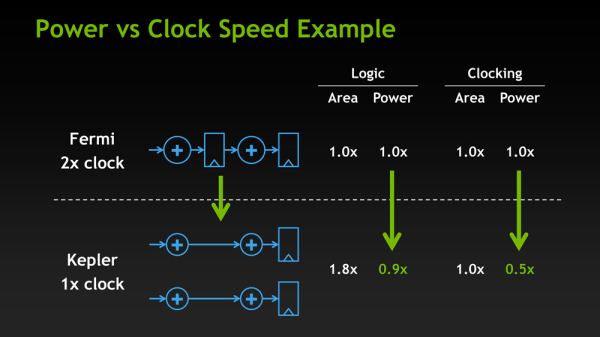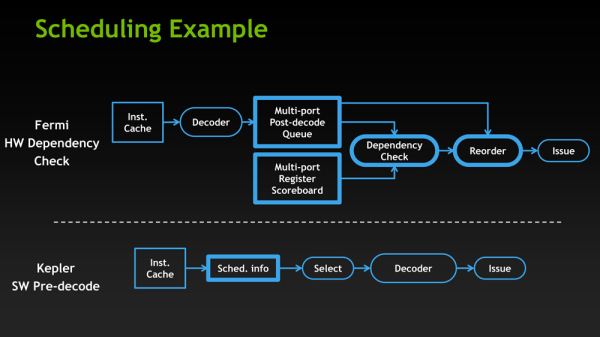NVIDIA GeForce GTX 680 Review: Retaking The Performance Crown
by Ryan Smith on March 22, 2012 9:00 AM ESTThe Kepler Architecture: Efficiency & Scheduling
So far we’ve covered how NVIDIA has improved upon Fermi for; now let’s talk about why.
Mentioned quickly in our introduction, NVIDIA’s big push with Kepler is efficiency. Of course Kepler needs to be faster (it always needs to be faster), but at the same time the market is making a gradual shift towards higher efficiency products. On the desktop side of matters GPUs have more or less reached their limits as far as total power consumption goes, while in the mobile space products such as Ultrabooks demand GPUs that can match the low power consumption and heat dissipation levels these devices were built around. And while strictly speaking NVIDIA’s GPUs haven’t been inefficient, AMD has held an edge on performance per mm2 for quite some time, so there’s clear room for improvement.
In keeping with that ideal, for Kepler NVIDIA has chosen to focus on ways they can improve Fermi’s efficiency. As NVIDIA's VP of GPU Engineering, Jonah Alben puts it, “[we’ve] already built it, now let's build it better.”
There are numerous small changes in Kepler that reflect that goal, but of course the biggest change there was the removal of the shader clock in favor of wider functional units in order to execute a whole warp over a single clock cycle. The rationale for which is actually rather straightforward: a shader clock made sense when clockspeeds were low and die space was at a premium, but now with increasingly small fabrication processes this has flipped. As we have become familiar with in the CPU space over the last decade, higher clockspeeds become increasingly expensive until you reach a point where they’re too expensive – a point where just distributing that clock takes a fair bit of power on its own, not to mention the difficulty and expense of building functional units that will operate at those speeds.
With Kepler the cost of having a shader clock has finally become too much, leading NVIDIA to make the shift to a single clock. By NVIDIA’s own numbers, Kepler’s design shift saves power even if NVIDIA has to operate functional units that are twice as large. 2 Kepler CUDA cores consume 90% of the power of a single Fermi CUDA core, while the reduction in power consumption for the clock itself is far more dramatic, with clock power consumption having been reduced by 50%.
Of course as NVIDIA’s own slide clearly points out, this is a true tradeoff. NVIDIA gains on power efficiency, but they lose on area efficiency as 2 Kepler CUDA cores take up more space than a single Fermi CUDA core even though the individual Kepler CUDA cores are smaller. So how did NVIDIA pay for their new die size penalty?
Obviously 28nm plays a significant part of that, but even then the reduction in feature size from moving to TSMC’s 28nm process is less than 50%; this isn’t enough to pack 1536 CUDA cores into less space than what previously held 384. As it turns out not only did NVIDIA need to work on power efficiency to make Kepler work, but they needed to work on area efficiency. There are a few small design choices that save space, such as using 8 SMXes instead of 16 smaller SMXes, but along with dropping the shader clock NVIDIA made one other change to improve both power and area efficiency: scheduling.
GF114, owing to its heritage as a compute GPU, had a rather complex scheduler. Fermi GPUs not only did basic scheduling in hardware such as register scoreboarding (keeping track of warps waiting on memory accesses and other long latency operations) and choosing the next warp from the pool to execute, but Fermi was also responsible for scheduling instructions within the warps themselves. While hardware scheduling of this nature is not difficult, it is relatively expensive on both a power and area efficiency basis as it requires implementing a complex hardware block to do dependency checking and prevent other types of data hazards. And since GK104 was to have 32 of these complex hardware schedulers, the scheduling system was reevaluated based on area and power efficiency, and eventually stripped down.
The end result is an interesting one, if only because by conventional standards it’s going in reverse. With GK104 NVIDIA is going back to static scheduling. Traditionally, processors have started with static scheduling and then moved to hardware scheduling as both software and hardware complexity has increased. Hardware instruction scheduling allows the processor to schedule instructions in the most efficient manner in real time as conditions permit, as opposed to strictly following the order of the code itself regardless of the code’s efficiency. This in turn improves the performance of the processor.
However based on their own internal research and simulations, in their search for efficiency NVIDIA found that hardware scheduling was consuming a fair bit of power and area for few benefits. In particular, since Kepler’s math pipeline has a fixed latency, hardware scheduling of the instruction inside of a warp was redundant since the compiler already knew the latency of each math instruction it issued. So NVIDIA has replaced Fermi’s complex scheduler with a far simpler scheduler that still uses scoreboarding and other methods for inter-warp scheduling, but moves the scheduling of instructions in a warp into NVIDIA’s compiler. In essence it’s a return to static scheduling.
Ultimately it remains to be seen just what the impact of this move will be. Hardware scheduling makes all the sense in the world for complex compute applications, which is a big reason why Fermi had hardware scheduling in the first place, and for that matter why AMD moved to hardware scheduling with GCN. At the same time however when it comes to graphics workloads even complex shader programs are simple relative to complex compute applications, so it’s not at all clear that this will have a significant impact on graphics performance, and indeed if it did have a significant impact on graphics performance we can’t imagine NVIDIA would go this way.
What is clear at this time though is that NVIDIA is pitching GTX 680 specifically for consumer graphics while downplaying compute, which says a lot right there. Given their call for efficiency and how some of Fermi’s compute capabilities were already stripped for GF114, this does read like an attempt to further strip compute capabilities from their consumer GPUs in order to boost efficiency. Amusingly, whereas AMD seems to have moved closer to Fermi with GCN by adding compute performance, NVIDIA seems to have moved closer to Cayman with Kepler by taking it away.
With that said, in discussing Kepler with NVIDIA’s Jonah Alben, one thing that was made clear is that NVIDIA does consider this the better way to go. They’re pleased with the performance and efficiency they’re getting out of software scheduling, going so far to say that had they known what they know now about software versus hardware scheduling, they would have done Fermi differently. But whether this only applies to consumer GPUs or if it will apply to Big Kepler too remains to be seen.












404 Comments
View All Comments
Sabresiberian - Thursday, March 22, 2012 - link
About what?Are you trying to blame the President for high video card prices?
Please.
CeriseCogburn - Thursday, March 22, 2012 - link
It's called inflation, try to get the idea, not some fanboy hurt.silverblue - Thursday, March 22, 2012 - link
What on earth is your problem? Where is there any sign of fanboyism in the three posts above you? He's got a valid point - cards are getting faster but they're getting more expensive at the same time.Successful troll is successful, it seems.
CeriseCogburn - Friday, March 23, 2012 - link
He said he got it in a sale. A few months ago it was $475 used on ebay (bitcoin).Many cards have come out at $500 and above.
The 580 was well over $500 for a long time, as was the 5870.
I guess you're mad because he;s wrong.
silverblue - Friday, March 23, 2012 - link
Reading comprehension isn't your friend. He's quite clearly talking about a 5870 that he bought for $325 when the prices were reduced two years back. He's also saying that there isn't a card in the region of $325 (give or take a few dollars) that is worth upgrading to right now, so in essence, he's asking what point there is to buying a new card.You're reading far too much into this. He still owns his 5870... which, by the way, never cost $500 at launch. The Eyefinity 6 Edition, perhaps, but not the vanilla 5870 - try $429 as an upper limit (and we're talking US Dollars; not my currency of choice but it's the norm for this site).
CeriseCogburn - Saturday, March 24, 2012 - link
Yes of course. So we have the 5870 v 7970 crysis W (page it happens to be on)40 vs 69
24 vs 42
16 vs 26
I see 3 resolutions where not or barely playable becomes playable.
So then it comes down to more exaggeration I objected to at the start.
I wouldn't object saying the 5870 can turn it down satisfy - but the increase is clearly game making.
Is it the GTX580 that was so far ahead yet denounced for core size and heat that is causing the disconnect ? I'd say so.
B-Unit1701 - Thursday, March 22, 2012 - link
Hence why Im still rocking a 4870. Picked one up almost exactly 3 years ago for $250, and haven't been convinced to upgrade until this generation. Will likely jump on a 7850 or a 7870 depending where prices land after nVidia's full launch.CeriseCogburn - Thursday, March 22, 2012 - link
The power envelope. The standard 300watts for pci-e (maybe they will raise it) is already exceeded on single cards.Where can you go but to 28mn and how is that not going to also bust power specs ?
Monitor resolutions have increased in 2 years.
OS has sucked up some.
Game patches enhance.
--
What's wrong is there is a limit that cannot be passed right now smaller nm must be achieved. Smaller ram with 4x the GB...
Two years may seem long but is it really ?
Many multi billion dollar upgrades to foundries require constant overhauls to move nodes.
Amazing is the whole thing hasn't collapsed already.
fhaddad78 - Thursday, March 22, 2012 - link
I'm confused by the dialog taking place in this conversation. Unless I am not understanding the results correctly, it seems to me the GTX 680 is a great card, there are some games where it performs really well, and there are other games where it's being outperformed by even older generation products. To me, this card (in it's current state) is more of a side-grade than an upgrade.Am I missing something?
prophet001 - Thursday, March 22, 2012 - link
only hysteria